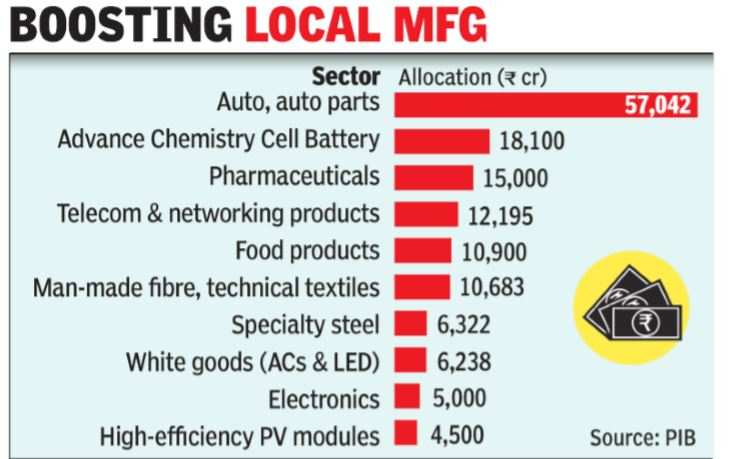The move is aimed at helping labour-intensive sectors such as textiles, food and automobiles and its components as well as high-end goods such as advanced batteries, including hydrogen fuel cells, and solar cells, while reducing the import of electronics, pharmaceuticals, speciality steel, white goods and telecom and networking equipment.
“It will give the right impetus to the economy because we are looking at ‘atmanirbharta’, making sure that India will be a part of the global value chain and ensuring that critical sunrise sectors get the necessary support from the government so that we are able to build a strong India that is able to service its own domestic market and also link up with the global value chains,” Finance Minister Nirmala Sitharaman said after the scheme was cleared by the Union cabinet.

The government had earlier announced Rs 41,000 crore PLIs for mobile manufacturing, which has seen Apple and Samsung along with some Indian vendors opt for the package. Similarly, a Rs 10,000-crore scheme was announced for indigenously produced bulk drugs and medical devices.
On August 3, TOI was the first to report about the details of the package being worked out. In several cases, the government had earlier raised customs duty or put checks on imports.
“The inclusion of high-demand high-technology items such as semi-conductor fab, IoT devices and ACC batteries in the newly announced PLI scheme will greatly boost India’s manufacturing capacities & catapult it among major manufacturing hubs. Looking forward to a huge positive impact,” said Bharat Forge chairman and MD Baba Kalyani.
The PLIs will be available over a five-year period and funds will be based on proposals finalised by a committee of officers.
The scheme is unlikely to put additional financial pressure on the government, which has limited the scope of several export incentives and limited them to duty refunds, resulting in savings. A part of these savings is to be deployed towards offering PLIs. But unlike the past when a large number of exporters would benefit from the incentives, the new mechanism is seen to be a more focused approach with the benefits expected to flow mainly to large producers, both domestic and global.
“Bringing food processing under the PLI scheme would revolutionise the sector. While India is world’s leading producer of fruits, vegetables and milk but the percentage of processing is much below the global average. We process only 7% of the total farm produce. The PLI scheme would help attracting more investment into the sector, both domestic and foreign investment,” said Godrej Group chairman Adi Godrej.
The government had for long shunned the idea of offering fiscal incentives to attract investments but the latest steps are seen to be reversing that trend as the government seeks to build a strong manufacturing base in the country to create jobs and reduce imports, especially from China. A large part of the imports in the segments that are now getting attention come from across the border with electronics, telecom equipment, solar cells and ACs being among them.
The government had been working on these incentives since the start of the year with the commerce and industry ministry doing the initial groundwork with industry bodies, before NITI Aayog and finance ministry joined in.







More News
Bank holidays in April 2024: Are banks open on Saturday, April 27, 2024? | India Business News – Times of India
PAN, Aadhaar not linked? Penalty deadline for TDS deductors extended – here’s what it means – Times of India
Reducing China dependence: Tata developing complex high-precision machines to make Apple iPhone casing; aims for exports – Times of India